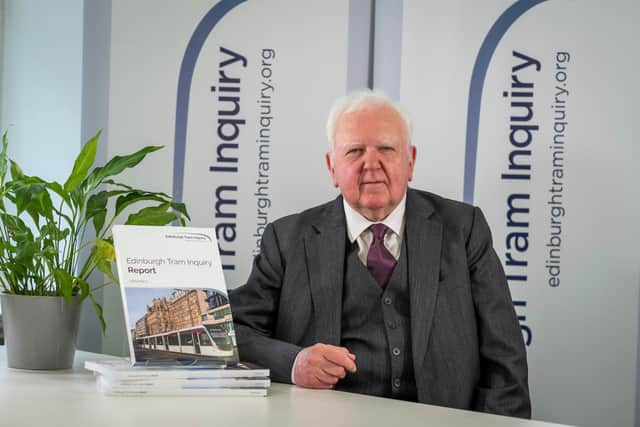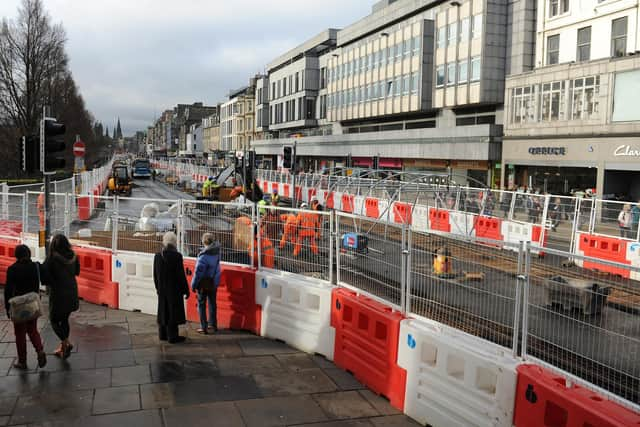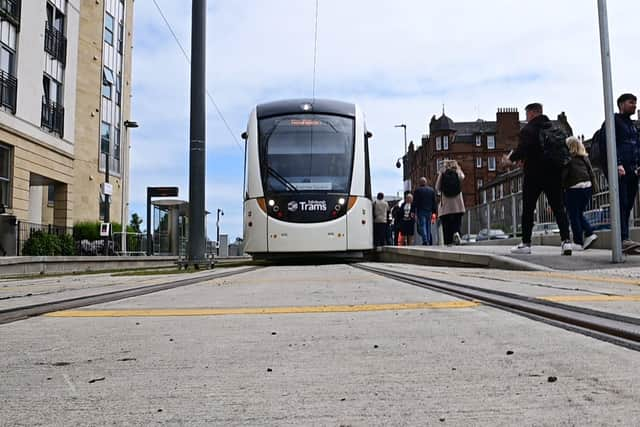Edinburgh tram inquiry: Lord Hardie's report blames Edinburgh council, TIE and Scottish Government
and live on Freeview channel 276
Edinbugh city council, its tram firm TIE and the Scottish Government are all blamed for a “litany of avoidable failures” which were responsible for the repeated delays and cost rises on Edinburgh’s tram project, the long-awaited report of Lord Hardie’s inquiry into the scheme said today.
He highlighted “considerable oversight, management and strategic mistakes” and made 24 recommendations, including consideration of possible new legislation to allow for civil and criminal sanctions against relevant individuals or companies who knowingly submit reports that include false statements to councillors.
Advertisement
Hide AdAdvertisement
Hide AdLord Hardie said: “The Inquiry process has been thorough and robust but also complex, with literally millions of documents that had to be carefully reviewed and detailed contractual issues to investigate. This work has been time-consuming but necessary to produce a report which not only provides answers to what went wrong with the Edinburgh Trams Project, but also clear recommendations for future transport projects.


“What is clear from the Inquiry’s work is that there was a litany of avoidable failures on the parts of several parties whose role it was to ensure that public funding was spent effectively and to the benefit of Scotland’s taxpayers, and that the Edinburgh Trams Project was delivered efficiently.
“Poor management and abdication of responsibility on a large scale have had a significant and lasting impact on the lives and livelihoods of Edinburgh residents, and the reputation of the city.”
Construction of Edinburgh’s tram project began in 2007 and took seven years, which saw massive disruption to Princes Street, Leith Walk and elsewhere, while costs soared from the original £545 million budget to a final figure of £776m.
Advertisement
Hide AdAdvertisement
Hide AdBut Lord Hardie’s report says the true cost was even more because some costs had been allocated under other headings and a landowner’s claim for compensation had not been taken into account.


The inquiry said: “Following the conclusion of the public hearings Lord Hardie reviewed the evidence in light of the closing submissions and the documentary productions and undertook investigations concerning the actual cost of the project. The reported cost was an understatement because Edinburgh Council allocated costs to other budgets that truly related to the project and failed to include the net present value of borrowing £231 million to complete the restricted line.
"There was also a substantial claim by a landowner of which there had been no awareness at the date of the reported cost. The best estimate of the cost of the restricted line is £835.7 million.”
The report says the main causes of the failure to deliver the project within budget included TIE’s departure from the procurement strategy that had been intended to manage risk out of the project; the failure of TIE to work collaboratively with the council and the contractors; failure by TIE to report accurately on progress and failure by council officials to monitor progress.
Advertisement
Hide AdAdvertisement
Hide AdHe also criticises the failure by TIE and the construction consortium, led by Bilfinger Beger to manage the design contract effectively, TIE’s failure to achieve the price certainty sought by the council and to transfer risk to the consortium in accordance with the procurement strategy.


He said the governance structure for the project did not follow any recognised model. “There was a lack of clarity as to who had responsibility for the performance of certain tasks and there was some overlap regarding the respective roles of the various bodies created, and individuals appointed, to deliver the project. It is also unclear whether all of the individuals appointed to specific roles actually fulfilled these roles.”
And he said council officials failed to protect the authority’s interests as the client and promoter of the project, bearing the risk of going over the allocated budget of £545 million.
And he said the Scottish Government’s decision to pull Transport Scotland out of involvement in the project after the SNP’s bid to scrap it was defeated in the Scottish Parliament in 2007, resulted in a loss of expertise and a lost opportunity to review the full business case and contract before it was signed.
Advertisement
Hide AdAdvertisement
Hide AdWhen the then First Minister Alex Salmond announced appointed Lord Hardie to conduct the inquiry in 2014 he promised it would be “swift and thorough”. But the report’s publication comes more than five years after the last pubic hearing. The inquiry began its pubic hearings in September 2017 and finished taking evidence in May 2018. The final cost of the inquiry is expected to top £13m.Former council leader Donald Anderson said most of the inquiry’s judgements were “pretty sound”. He said: “TIE went rogue, nobody controlled TIE, nobody took a grip of the situation within the council, either administratively or among elected members and TIE was allowed to do whatever it wanted. It was an arms-length company but the arms were way too long.”
Lothian Tory MSP Miles Briggs highlighted Lord Hardie’s criticism of the government. “He is clear that ministers failed to protect the public purse and acted in the SNP’s political interests, rather than the public interest. John Swinney, especially, has questions to answer for removing safeguards that would have protected grant funds. The SNP government must now respond to this damning indictment of a fiasco that dragged on for more than a decade, and resulted in huge avoidable costs to the Scottish taxpayer.”
Transport Secretary Mairi McAllan said the government would have to take time to consider the report. But she said: “The inquiry took too long, was too costly and in some instances the evidence heard does not support the conclusion drawn.”